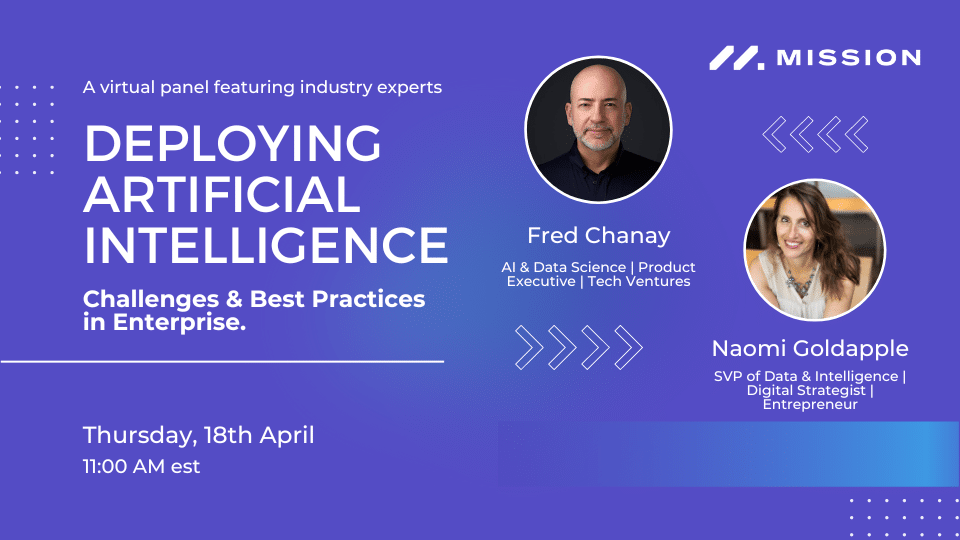During a recent virtual panel organized by Mission for their community of software building talent and broader network of professionals, key speakers Fred Chanay and Naomi Goldapple provided their invaluable insights on the deployment of artificial intelligence in enterprise environments. Moderated by Gabriel Sundaram, co-founder of Mission, the discussion illuminated the profound impact and strategic importance of AI across various sectors.
AI in Enterprise: Hype vs. Reality
Fred Chanay addressed the sweeping enthusiasm and subsequent recalibration of expectations surrounding generative AI in corporate environments. He stated, “The GenAI tsunami in the corporate world changed the way AI was perceived in corporate America… I think we’re slowly coming back to earth as people realize it’s hard to develop enterprise-grade apps with Gen AI, and the overall market is still bullish.” This quote reflects the journey from the peak of inflated expectations to a more grounded and practical approach to AI applications in business..
Strategic Importance of AI in Various Sectors
Naomi Goldapple discussed the transformative role of AI in managing home healthcare, where it’s used to optimize scheduling, predict patient risks, and enhance the delivery of care. At AlayaCare, AI supports around six million visits per month, significantly improving operational efficiency and patient outcomes. She emphasized, “By predicting potential staff turnovers and optimizing work schedules, AI not only enhances operational efficiency but also improves patient care outcomes,” highlighting the practical benefits of AI in critical sectors.
The Value and Role of Proof of Concepts (POCs)
Chanay emphasized the critical role that Proof of Concepts (POCs) play in the implementation and testing of AI technologies within enterprises. He noted, “It’s important to develop the reflex of innovating and trying new tech, especially in large organizations… Although I have a tendency to believe that efforts/resources are better spent in areas where you can create competitive advantage.” This perspective underlines the importance of POCs in not just testing viability but also in strategically directing resources towards impactful AI implementations.
Goldapple discussed how POCs are instrumental in validating AI technologies in real-world settings. She highlighted the cooperative nature of these projects: “What we have found works really well is to build POCs with validation partners, with our customers in a co-design arrangement… With LLMs POCs have been invaluable to gauge how deterministic they can be.” Her insights reflect the importance of collaboration with stakeholders to ensure that AI solutions are both practical and effective before full-scale deployment.
From POC to Production: Challenges and Best Practices
As businesses transition from proof of concept to full production, Chanay highlighted the necessity of maintaining a larger strategic vision. He advised, “For a large company, it’s all about having a larger picture in mind… Don’t forget governance – from the start, including legal if needed.” His comments underscore the importance of foresight and comprehensive planning in scaling AI solutions, ensuring they are robust and compliant across all organizational levels.
Deploying AI in Regulated Industries
Goldapple elaborated on the challenges of integrating AI into the healthcare sector, where regulations are stringent and the stakes are high. She pointed out the critical need for AI tools to augment rather than replace human decision-making, ensuring that they are used as decision support systems. She emphasized, “Ensure that AI is always built as a decision support tool and not prescriptive… navigating the regulatory landscape in healthcare and implementing AI solutions compliantly is crucial.”
Considerations for AI in Regulated Industries:
- Compliance with Health Regulations: AI applications must adhere to a complex web of health regulations, including patient privacy laws like HIPAA in the U.S., which governs the use and disclosure of personal health information.
- Ethical Implications: The use of AI in healthcare must consider ethical issues, such as bias in AI algorithms that could lead to unequal treatment or outcomes for different patient groups.
- Data Integrity and Security: Ensuring the accuracy, integrity, and security of data used by AI systems is paramount, especially in healthcare, where data errors can have life-or-death consequences.
- Collaboration with Regulatory Bodies: Continuous dialogue and collaboration with regulatory bodies are essential to navigate the evolving landscape of AI regulations and to ensure that AI solutions are both innovative and compliant.
Strategies for Successful Implementation:
- Developing Transparent AI Systems: Creating AI systems with transparent decision-making processes helps in gaining trust from both regulators and the user base, particularly clinicians who rely on these tools.
- Engaging Stakeholders: Including stakeholders like healthcare professionals and patients in the design and implementation process can help tailor AI solutions to meet actual needs while addressing potential concerns about technology.
Ethics and Responsibility in AI Deployment
Chanay emphasized the importance of educating peers about the capabilities and limitations of AI. He remarked, “Education of peers is key. For GenAI, focus on what it is good at… In the end, AI in enterprise is all about the data and the ability to work closely with the product and SW teams.” This approach helps set realistic expectations and ensures that AI is used effectively within its actual capabilities, avoiding overselling or misapplications that can lead to mistrust or ethical dilemmas.
Broader Ethical Considerations:
The deployment of AI also raises broader ethical considerations that need to be addressed to maintain public trust and compliance with ethical standards. These include:
- Bias and Fairness: Ensuring AI systems do not perpetuate or exacerbate existing biases, which requires rigorous testing and constant monitoring.
- Privacy Concerns: Safeguarding personal data used by AI systems to prevent breaches and misuse, aligning with privacy laws and ethical norms.
- Impact on Employment: Navigating the changes AI may bring to the workforce, including potential job displacements and the need for re-skilling workers.
The Future of AI in Enterprise
Optimism and Realism in AI Evolution:
The future of AI in enterprise settings is viewed with a blend of optimism and realism by industry experts. Both Fred Chanay and Naomi Goldapple express a forward-looking vision while acknowledging the challenges that lie ahead. They agree that as AI technologies mature, businesses will need to adapt continuously to leverage these tools effectively.
Innovative Potential Across Industries:
AI is expected to continue transforming business processes across various industries. Its capacity to analyze vast amounts of data and provide insights can lead to significant improvements in efficiency, decision-making, and customer engagement. Industries particularly poised for transformation include healthcare, manufacturing, and services, where AI can optimize operations, enhance predictive maintenance, and personalize customer interactions.
Strategies for Sustainable AI Integration:
- Continuous Learning and Adaptation: Businesses must foster a culture of continuous learning to keep pace with AI advancements. This involves regular training and development for employees to ensure they can effectively work with new AI tools and concepts.
- Collaborative Ecosystems: Establishing partnerships between AI developers, businesses, and regulatory bodies will be crucial. These collaborations can help tailor AI solutions to specific industry needs while ensuring they meet regulatory standards and ethical considerations.
- Scalability and Flexibility: Enterprises should focus on creating scalable and flexible AI systems that can evolve with changing market demands and technological advancements.
Addressing Challenges:
To fully realize AI’s potential, businesses will need to address several challenges:
- Integration with Existing Systems: Seamlessly integrating AI with legacy systems poses technical and logistical challenges that require thoughtful planning and execution.
- Data Management and Security: As AI systems rely heavily on data, ensuring the integrity and security of this data is paramount. Businesses must implement robust data governance practices to protect sensitive information and ensure compliance with data protection laws.
- Public Perception and Trust: Maintaining public trust in AI systems will be critical. This involves clear communication about AI’s role, capabilities, and limitations, as well as transparent reporting on AI outcomes.
Conclusion
The virtual panel hosted by Mission provided profound insights into the deployment of artificial intelligence in enterprise environments, with key contributions from the experts. Their discussions highlighted the nuanced realities of AI integration, from the initial hype to the strategic and ethical considerations necessary for successful implementation.
Fred Chanay and Naomi Goldapple provided a comprehensive overview of the challenges and opportunities presented by AI across various sectors, including healthcare, manufacturing, and human resource management. Their insights into the practical applications of AI, the importance of proof of concepts, and the transition from POCs to production outlined critical steps for organizations aiming to leverage AI technologies effectively.
Furthermore, the panelists discussed the ethical responsibilities involved in AI deployment, emphasizing the need for education, transparency, and accountability, especially in regulated industries like healthcare. They also explored the future potential of AI in transforming business landscapes, stressing the importance of continuous innovation and adaptation to maintain competitive advantage.


